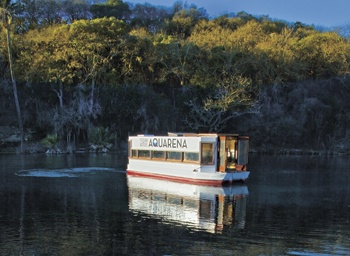Some 12,000 years ago, early Native Americans stumbled upon the banks of a river so beautiful it stopped them in their tracks. Cold, clear springs shot up like fountains from the river’s headwaters, and mammoths, mastodons and bison roamed its banks.
Here, thanks to the springs, was plentiful water. Here, thanks to the animals and abundant vegetation, was food, clothing, shelter and tools. Here, after extensive wandering in an unnamed and untamed land, was home.
Today, passengers on glass-bottom boats enjoy crystal-clear views of the San Marcos Springs that seem to boil up from the limestone fissures of the Edwards Aquifer. As they glide over Spring Lake, the turquoise jewel of an environmental education center called the Aquarena Center, boat drivers direct passengers’ attention to an underwater dig site that has led many archaeologists to a bold conclusion: This is the oldest continually inhabited site in North America.
In 1978, archaeologist Joel Shiner began a decade-long excavation of the site. The volume of his findings and the superb condition of the artifacts, such as artfully made spear points, indicate that early Native Americans, or Paleo-Indians, weren’t just nomadic tribes passing through. Instead, seduced by the spring-fed waters of the San Marcos River, they established permanent communities along its banks.
Shiner’s finds included bones from extinct species including bison twice the size of a modern buffalo. And most significantly, he unearthed evidence that a tribe he labeled the Spring Lake Indians may have been here first—not the Clovis people, who generally are considered the first inhabitants of North America.
Some researchers believe that the area surrounding the San Marcos Springs has been occupied during every known period of human habitation in Central Texas. One of the most influential settlers was Gen. Edward Burleson, who in 1849 built a dam across the San Marcos River to operate a gristmill. The dam created Spring Lake, sealing archaeological artifacts beneath its surface for more than 100 years.
But while the past remained buried, another San Marcos-based developer was revealing even bigger plans—plans that would lead to the creation of an aquatic theme park that drew visitors by the thousands long before places like Six Flags Over Texas, which opened in 1961, were constructed.
In 1926, Arthur Birch (A.B.) Rogers bought 125 acres from the San Marcos Utilities Company along the San Marcos River’s headwaters. According to the San Marcos Record, he wanted to create “one of the great playgrounds of Texas and the Southwest.”
Rogers enacted that plan on April 22, 1929, when he opened the Rogers Spring Lake Park Hotel. Guests dined, played golf on a new course, swam in the sparkling spring-fed water and danced on the hotel roof until the wee hours of the morning.
Rogers, meanwhile, was always looking beneath the surface, and his vision of a tourist playground included the glass-bottom boats he had once seen at Catalina Island, California. His son, Paul Rogers, shared that dream and in 1946 built a small canvas-covered boat with a viewing glass in the bottom. Then, on August 9, 1947, he launched what would become the heart and soul of Aquarena Springs: a glass-bottom boat that could hold 25 passengers.
Paul Rogers’ vision widened during a 1949 family vacation to Florida when he was taken with the electric-powered glass-bottom boats at Silver Springs Nature Park. And at Weeki Wachee Springs State Park, he was so impressed with an underwater show and its mermaid performers that he eventually convinced the show’s manager, Don Russell, to move to Texas to manage a new aquatic theme park and oversee construction of a submarine theater: an aqua arena.
From the get-go in San Marcos, the sky was the limit: The Aquarena theme park opened on October 3, 1950, and in 1951, visitors filled what was billed as the world’s only submarine theater. Paul Rogers opened Texana Village, a frontier town exhibit, on the grounds in 1958, and five years later introduced the Swiss Sky Ride that offered visitors a 110-foot-high view from gondolas.
Although the Aquarena Springs era came to an end, the stories never will. Bob Phillips, whose father, Gene Phillips, served as president and general manager from 1971-85, is filming “The Stories of Aquarena Springs,” a documentary set for release this spring.
And Images of America: Aquarena Springs—the book written by A.B. Rogers’ great-granddaughter Doni Weber—beautifully captures the theme park’s story.
“The bottom line is, they loved the river,” Weber said of her great-grandfather and grandfather. “They could’ve turned this into a subdivision. It could be nothing but houses right now, and yet they wanted it to focus on the river.”
A.B. Rogers and Paul Rogers didn’t know the word “ecotourism,” Weber said. “They just thought, ‘Well, it’s a beautiful river. Let’s let people ride around in boats and look at what’s underneath.’ ”

